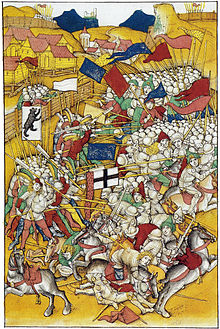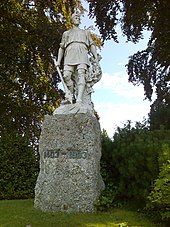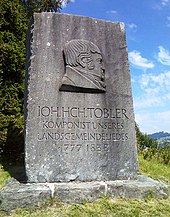Battle of Vögelinsegg

Map of the municipality of St. Gallen. The battle took place in the “hole” between the Less pond and the eastern border of the canton of Appenzell Ausserrhoden towards Speicher.
| date | May 15, 1403 |
|---|---|
| place | Approx. 1 km northwest of the Vögelinsegg pass near Speicher |
| output | Appenzell victory |
| Parties to the conflict | |
|---|---|
| Commander | |
|
|
|
| Troop strength | |
| approx. 4000 | about 400 |
| losses | |
|
about 300 |
approx 8 |
Vögelinsegg - Rotmonten - Stoss - Bregenz - Herisau
The Battle of Vögelinsegg was a military conflict between Appenzell and the Prince Abbey of St. Gallen during the Appenzell Wars . It took place on May 15, 1403 in the so-called Loch between Speicher and St. Gallen in today's Canton of St. Gallen .
prehistory
Due to the economic decline of the St. Gallen monastery sought Appenzell as well as the thriving city of St. Gallen for more political self-determination. The Appenzell communities (owned by the monastery since the 11th century) Appenzell , Gais , Hundwil , Teufen and Urnäsch succeeded in gaining their own imperial rights over time . The independence of these communities was so great in the second half of the 14th century that they joined the Swabian Association of Cities .
The trigger of the conflict was the hard tax collection of the monastery of St. Gallen. At the beginning of 1401 the situation came to a head. Appenzell sought rapprochement with the city of St. Gallen and initially entered into an alliance with it. The council of St. Gallen accused the abbot Kuno von Stoffeln of wanting to enter into an alliance with the noble family of the Habsburgs . Various places in the area joined the Bund, whose main town was now the city of St. Gallen. This decisive step moved the Austrian duke to enter into an alliance with the abbot of St. Gallen , especially since the unrest in the Appenzell region spread rapidly.
When it came down to it, the cities allied with the Appenzellers refused to help out of fear of war, and even forced the city of St. Gallen in an arbitration award in 1402 to terminate the alliance, so that Appenzell was initially alone. They sought contact with like-minded people and found them in the Swiss town of Schwyz , with which they entered into a land rights contract in the spring of 1403 . The Schwyzer promised them military help and experienced managers. Then the hostilities started. The abbot planned to nip the revolt in the bud with a major military strike against the capital Appenzell .
course

According to tradition, the campaign plan is said to have been brought to the Appenzell people by market women from St. Gallen. Under the guidance of the Schwyzer captains, they blocked the road at Vögelinsegg with a Letzi . Behind and on the surrounding hills they lay in wait for the abbot's army.
The abbot's army approached, divided into three squadrons in a militarily correct manner. At the top 200 carpenters to clear any obstacles out of the way, then a group of selected shooters and finally the main archer. The enthusiasm for the war and the inner cohesion should not have been particularly great. In addition, the leaders fell victim to the mistake of indifferent commanders. They expected a peasant rebel army without a clue of the nature of the art of war and expected an easy victory. The advance took place without reconnaissance or security.
So the army literally fell into the trap of the prepared Appenzellers and Schwyzers. The top was still busy breaking the Letzimauer when the Appenzell broke into the army under a prepared hail of large stones. At first they attacked head-on and surprisingly hit the flank of the enemy with the main force from the south. Its leaders were unable to exploit their tactical advantages and numerical superiority in the narrow terrain of the ravine. The shooters sent ahead did not get a shot at all. The abbot tables were literally knocked down in a quick and bloody fight.
The abbot vanguard turned to flee and dragged along with the infantry , which had just marched up to order. The army was pursued by the Appenzell people to the gates of the city of St. Gallen. They killed everyone they could get hold of and set fire to the houses outside the city walls. Above all, around 300 men fell from the contingents of the Lake Constance cities, whereas the Appenzell people, according to tradition, only lost eight men.
consequences
Due to the abbot's defeat, the alliance with the Lake Constance cities immediately broke up, and the citizens of St. Gallen now openly sided with the Appenzell people. In April 1404 a peace treaty followed between the Lake Constance cities and Appenzell. On the other hand, Duke Friedrich IV of Habsburg himself intervened in the event. Originally not an enthusiastic ally of the abbot, he offered to help and made the fight against the rebellious peasants his own. He recognized the opportunity to curb the spreading self-employment movement in the Lake Constance area and to strengthen his own position. A military coup should also serve as a warning to the Confederates .
The first thing he did was to inform the Schwyzers of the twenty-year peace that had existed since 1394. This forbade the Schwyzers to support Austrian enemies and thus forced them to withdraw from the matter, which they reluctantly did (the Appenzellers, however, remained in Schwyz land law ). He submitted requests for help to the cities within his sphere of influence and, with reference to the terms of the peace treaty, even to the federal cities of Zurich , Bern , Lucerne and Solothurn , which, however, refused, since the borders of the Austrian sphere of influence would turn back in the direction of a success of Friedrich Confederation would have moved. After two years of guerrilla warfare, the Battle of the Stoss broke out on June 17, 1405 .
monument
The battle memorial was created by Otto Steiger and inaugurated on July 12, 1903. The sculpture depicts a warning Appenzell farmer with a morning star from the year with a peering gaze towards the nearby city of St. Gallen. The monument is located, contrary to the actual scene, about one kilometer south-east on the crest of the Vögelinsegg. A memorial stone for Johann Heinrich Tobler , the composer of the Appenzell Landsgemeindeliedes, was erected east of the street in 1938 .
See also
Individual evidence
Web links
- Karl Heinz Burmeister: Battle of Vögelinsegg. In: Historical Lexicon of Switzerland .
- Brandenberger 2004, doi : 10.5169 / seals-405395
Coordinates: 47 ° 25 '9 " N , 9 ° 25' 25.9" E ; CH1903: seven hundred and forty-nine thousand seven hundred ninety-five / 253934

